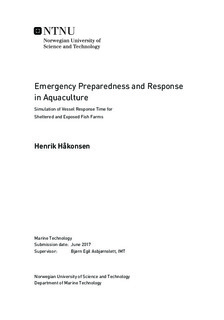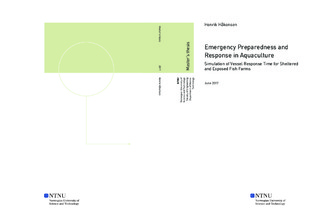| dc.description.abstract | This master s thesis investigates emergency preparedness and response in Norwegian
aquaculture using discrete-event simulation. The aquaculture industry is growing in terms of
production, size, and technology, with the first exposed salmon farm expected in offshore
waters by the end of 2017. One should therefore prepare and plan for new challenges. This
thesis considers emergency preparedness and response for current and future aquaculture. The
emergencies considered involve loss of biomass.
The system limitations are set to when salmon is located in cages at sea. Relevant literature
considering emergency preparedness and response in aquaculture is evaluated. Emergency
preparedness and response is defined as planning for emergency, and the reactive actions
performed after emergency. To gain insight, relevant literature from other segments is also
assessed.
A discrete-event simulation model is developed in SimEvents, to serve as a tool in the analysis.
The model is developed as a generic basis to handle different emergency types. The modeled
system is constructed to determine response time and time until the emergency is eliminated,
based on various input data. The correlation between input data and calculations with the system
is illustrated. The input data is mostly based on research, thereby causing variations in accuracy.
The simulation model is used to evaluate emergency escape and emergency slaughter.
A case study with three cases is carried out to show the application and diversity of the
simulation model. All three cases contain several scenarios with changing input data. The two
first cases considers response time for wellboats and light diving vessels upon first arrival at
the emergency site. With varying probability and distribution input, simulations are performed
for one sheltered fish farm and one exposed fish farm. Further, the case study considers different
fleet compositions to empty the two fish farms, with varying stock sizes.
Each simulation provides different output due to stochastic variables, such as wave height and
mobilization time. The results show that it is possible to obtain the same response times for the
exposed fish farm by increasing the availability of response vessels. Further, the case study
shows that a significantly larger capacity is needed for emergency slaughter in exposed areas.
Lastly, the case study shows that poor utilization decreases performance offshore when one
large vessel is used, instead of several smaller vessels.
The thesis concludes that increased focus on preparedness and response in the growing
aquaculture industry is needed. Both to improve procedures and planning, to prevent loss of
biomass in emergency. The case study concludes that it is highly possible to achieve a
satisfactory level of preparedness and response for exposed fish farming, but standby vessels
may be necessary. Furthermore, increased incentives are suggested to improve current planning
and communication procedures, level of standardization, as well as ensuring capacities before
emergency occurs. | |

